Reflective Portfolio: Leadership, Ethics, and Innovation
VerifiedAdded on 2020/12/18
|13
|4599
|298
Report
AI Summary
This reflective portfolio delves into the student's insights on leadership, focusing on autonomous approaches to professional learning, ethical processes within a business environment, and organizational knowledge and innovation. The portfolio explores the concept of autonomy, emphasizing its role in fostering employee freedom, positive work environments, and increased job satisfaction. It examines the importance of ethical business practices, highlighting principles such as honesty, integrity, promise-keeping, caring, fairness, and loyalty. The student reflects on how these principles contribute to building trust, maintaining strong relationships, and promoting organizational success. The portfolio also discusses the role of autonomous approaches in enhancing employee employability, reducing employee turnover, and fostering continuous learning. Furthermore, it explores how ethical considerations influence decision-making, stakeholder relationships, and overall business performance. The report also covers the importance of applying ethical business practices and the factors that influence ethical decision-making. This study is based on a reflective log of 120 practice hours & email.
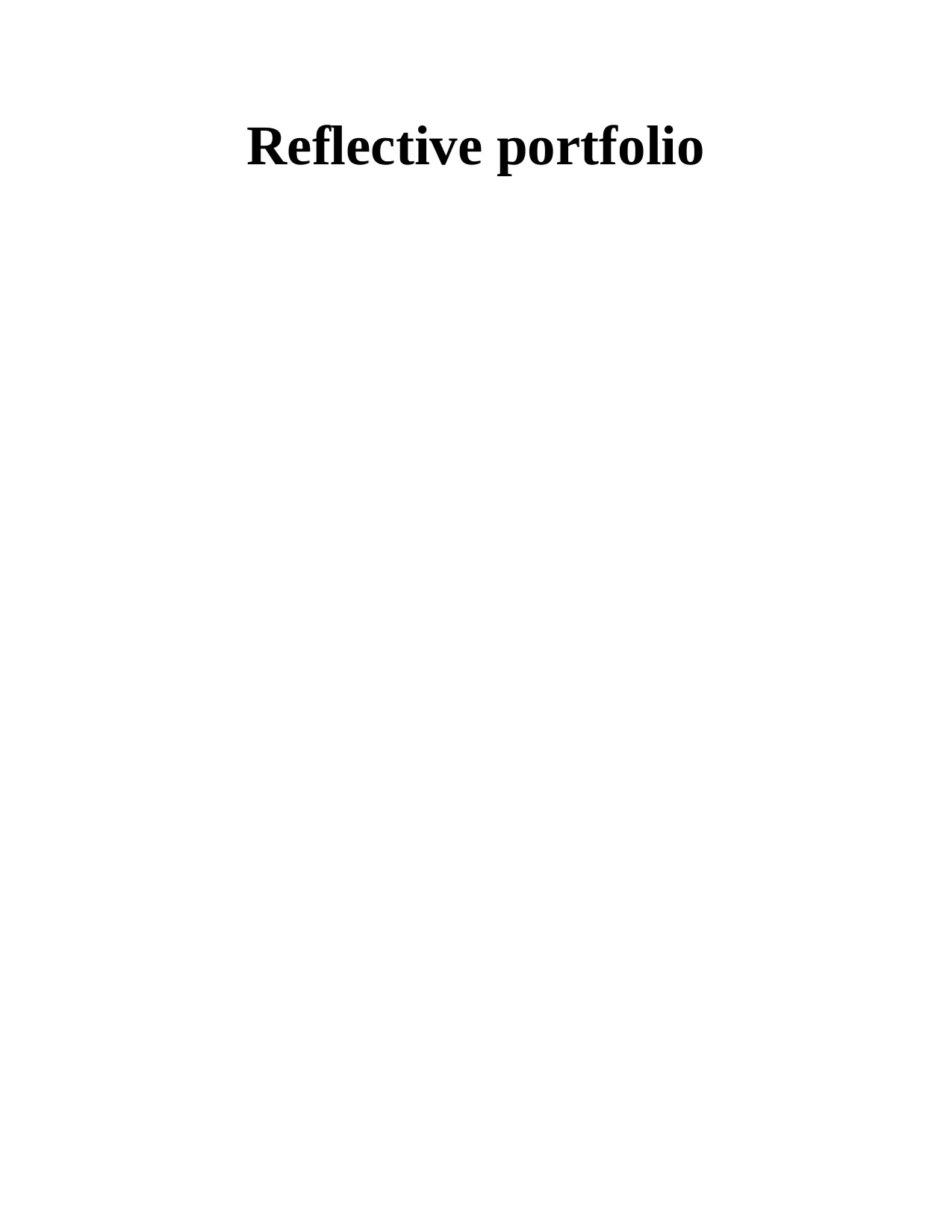
Reflective portfolio
Paraphrase This Document
Need a fresh take? Get an instant paraphrase of this document with our AI Paraphraser
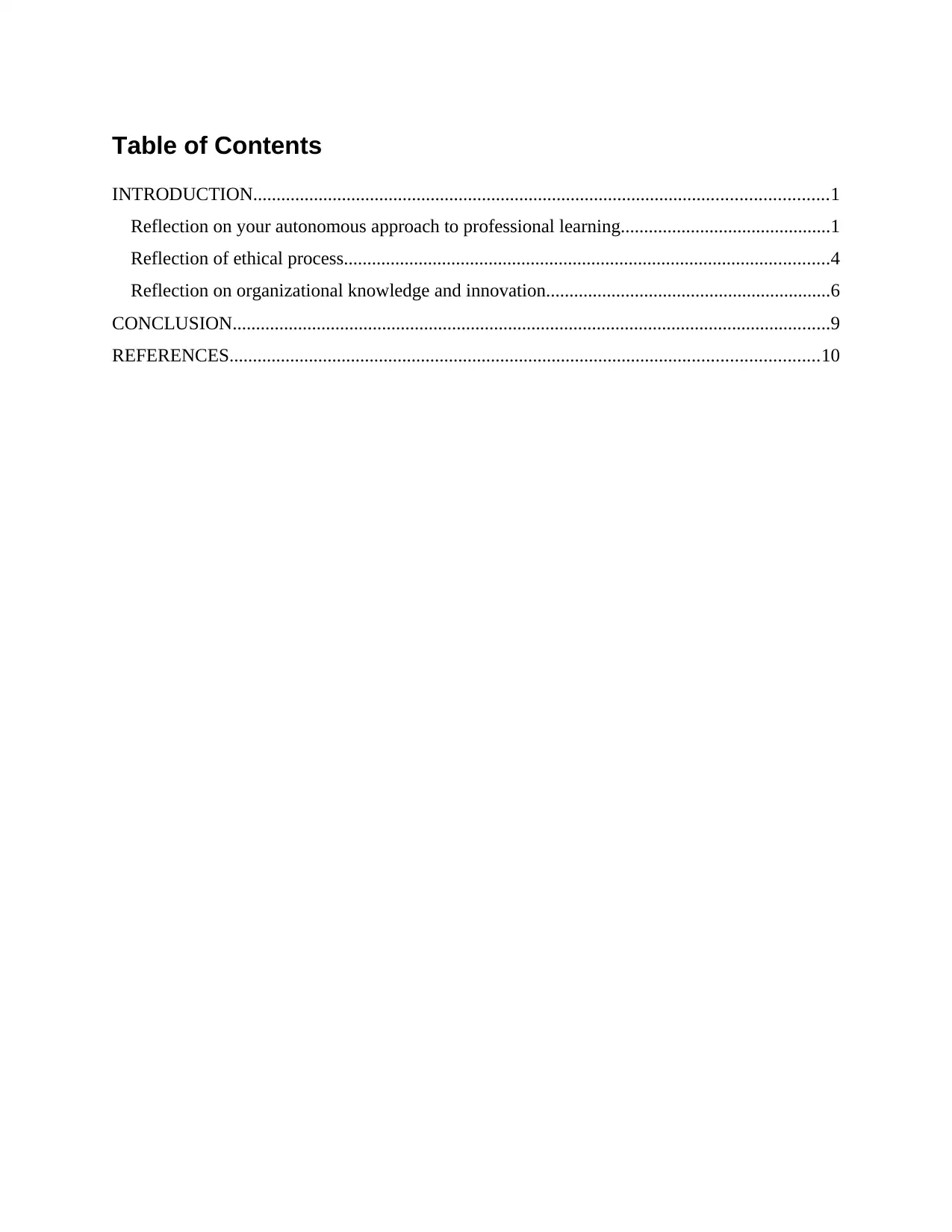
Table of Contents
INTRODUCTION...........................................................................................................................1
Reflection on your autonomous approach to professional learning.............................................1
Reflection of ethical process........................................................................................................4
Reflection on organizational knowledge and innovation.............................................................6
CONCLUSION................................................................................................................................9
REFERENCES..............................................................................................................................10
INTRODUCTION...........................................................................................................................1
Reflection on your autonomous approach to professional learning.............................................1
Reflection of ethical process........................................................................................................4
Reflection on organizational knowledge and innovation.............................................................6
CONCLUSION................................................................................................................................9
REFERENCES..............................................................................................................................10
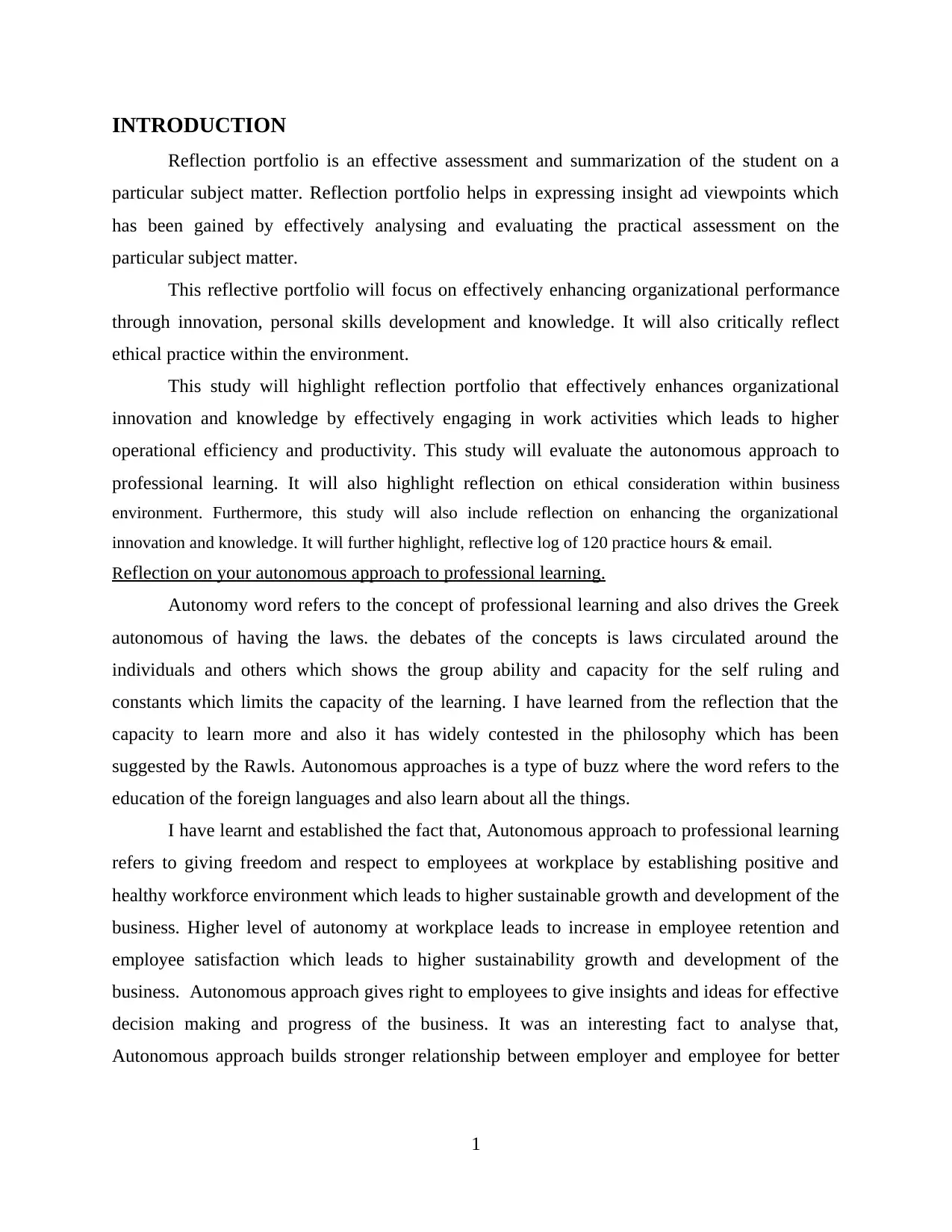
INTRODUCTION
Reflection portfolio is an effective assessment and summarization of the student on a
particular subject matter. Reflection portfolio helps in expressing insight ad viewpoints which
has been gained by effectively analysing and evaluating the practical assessment on the
particular subject matter.
This reflective portfolio will focus on effectively enhancing organizational performance
through innovation, personal skills development and knowledge. It will also critically reflect
ethical practice within the environment.
This study will highlight reflection portfolio that effectively enhances organizational
innovation and knowledge by effectively engaging in work activities which leads to higher
operational efficiency and productivity. This study will evaluate the autonomous approach to
professional learning. It will also highlight reflection on ethical consideration within business
environment. Furthermore, this study will also include reflection on enhancing the organizational
innovation and knowledge. It will further highlight, reflective log of 120 practice hours & email.
Reflection on your autonomous approach to professional learning.
Autonomy word refers to the concept of professional learning and also drives the Greek
autonomous of having the laws. the debates of the concepts is laws circulated around the
individuals and others which shows the group ability and capacity for the self ruling and
constants which limits the capacity of the learning. I have learned from the reflection that the
capacity to learn more and also it has widely contested in the philosophy which has been
suggested by the Rawls. Autonomous approaches is a type of buzz where the word refers to the
education of the foreign languages and also learn about all the things.
I have learnt and established the fact that, Autonomous approach to professional learning
refers to giving freedom and respect to employees at workplace by establishing positive and
healthy workforce environment which leads to higher sustainable growth and development of the
business. Higher level of autonomy at workplace leads to increase in employee retention and
employee satisfaction which leads to higher sustainability growth and development of the
business. Autonomous approach gives right to employees to give insights and ideas for effective
decision making and progress of the business. It was an interesting fact to analyse that,
Autonomous approach builds stronger relationship between employer and employee for better
1
Reflection portfolio is an effective assessment and summarization of the student on a
particular subject matter. Reflection portfolio helps in expressing insight ad viewpoints which
has been gained by effectively analysing and evaluating the practical assessment on the
particular subject matter.
This reflective portfolio will focus on effectively enhancing organizational performance
through innovation, personal skills development and knowledge. It will also critically reflect
ethical practice within the environment.
This study will highlight reflection portfolio that effectively enhances organizational
innovation and knowledge by effectively engaging in work activities which leads to higher
operational efficiency and productivity. This study will evaluate the autonomous approach to
professional learning. It will also highlight reflection on ethical consideration within business
environment. Furthermore, this study will also include reflection on enhancing the organizational
innovation and knowledge. It will further highlight, reflective log of 120 practice hours & email.
Reflection on your autonomous approach to professional learning.
Autonomy word refers to the concept of professional learning and also drives the Greek
autonomous of having the laws. the debates of the concepts is laws circulated around the
individuals and others which shows the group ability and capacity for the self ruling and
constants which limits the capacity of the learning. I have learned from the reflection that the
capacity to learn more and also it has widely contested in the philosophy which has been
suggested by the Rawls. Autonomous approaches is a type of buzz where the word refers to the
education of the foreign languages and also learn about all the things.
I have learnt and established the fact that, Autonomous approach to professional learning
refers to giving freedom and respect to employees at workplace by establishing positive and
healthy workforce environment which leads to higher sustainable growth and development of the
business. Higher level of autonomy at workplace leads to increase in employee retention and
employee satisfaction which leads to higher sustainability growth and development of the
business. Autonomous approach gives right to employees to give insights and ideas for effective
decision making and progress of the business. It was an interesting fact to analyse that,
Autonomous approach builds stronger relationship between employer and employee for better
1
⊘ This is a preview!⊘
Do you want full access?
Subscribe today to unlock all pages.

Trusted by 1+ million students worldwide
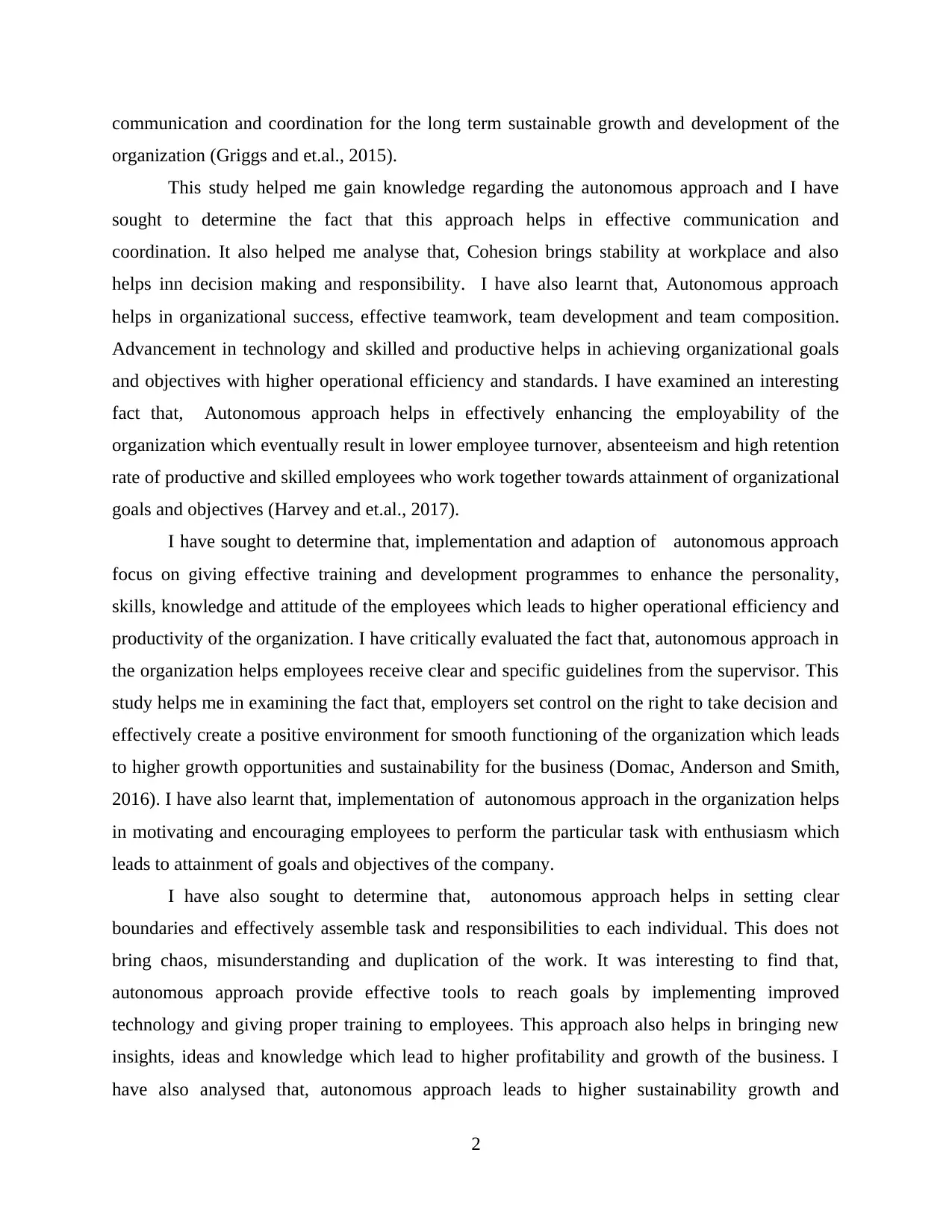
communication and coordination for the long term sustainable growth and development of the
organization (Griggs and et.al., 2015).
This study helped me gain knowledge regarding the autonomous approach and I have
sought to determine the fact that this approach helps in effective communication and
coordination. It also helped me analyse that, Cohesion brings stability at workplace and also
helps inn decision making and responsibility. I have also learnt that, Autonomous approach
helps in organizational success, effective teamwork, team development and team composition.
Advancement in technology and skilled and productive helps in achieving organizational goals
and objectives with higher operational efficiency and standards. I have examined an interesting
fact that, Autonomous approach helps in effectively enhancing the employability of the
organization which eventually result in lower employee turnover, absenteeism and high retention
rate of productive and skilled employees who work together towards attainment of organizational
goals and objectives (Harvey and et.al., 2017).
I have sought to determine that, implementation and adaption of autonomous approach
focus on giving effective training and development programmes to enhance the personality,
skills, knowledge and attitude of the employees which leads to higher operational efficiency and
productivity of the organization. I have critically evaluated the fact that, autonomous approach in
the organization helps employees receive clear and specific guidelines from the supervisor. This
study helps me in examining the fact that, employers set control on the right to take decision and
effectively create a positive environment for smooth functioning of the organization which leads
to higher growth opportunities and sustainability for the business (Domac, Anderson and Smith,
2016). I have also learnt that, implementation of autonomous approach in the organization helps
in motivating and encouraging employees to perform the particular task with enthusiasm which
leads to attainment of goals and objectives of the company.
I have also sought to determine that, autonomous approach helps in setting clear
boundaries and effectively assemble task and responsibilities to each individual. This does not
bring chaos, misunderstanding and duplication of the work. It was interesting to find that,
autonomous approach provide effective tools to reach goals by implementing improved
technology and giving proper training to employees. This approach also helps in bringing new
insights, ideas and knowledge which lead to higher profitability and growth of the business. I
have also analysed that, autonomous approach leads to higher sustainability growth and
2
organization (Griggs and et.al., 2015).
This study helped me gain knowledge regarding the autonomous approach and I have
sought to determine the fact that this approach helps in effective communication and
coordination. It also helped me analyse that, Cohesion brings stability at workplace and also
helps inn decision making and responsibility. I have also learnt that, Autonomous approach
helps in organizational success, effective teamwork, team development and team composition.
Advancement in technology and skilled and productive helps in achieving organizational goals
and objectives with higher operational efficiency and standards. I have examined an interesting
fact that, Autonomous approach helps in effectively enhancing the employability of the
organization which eventually result in lower employee turnover, absenteeism and high retention
rate of productive and skilled employees who work together towards attainment of organizational
goals and objectives (Harvey and et.al., 2017).
I have sought to determine that, implementation and adaption of autonomous approach
focus on giving effective training and development programmes to enhance the personality,
skills, knowledge and attitude of the employees which leads to higher operational efficiency and
productivity of the organization. I have critically evaluated the fact that, autonomous approach in
the organization helps employees receive clear and specific guidelines from the supervisor. This
study helps me in examining the fact that, employers set control on the right to take decision and
effectively create a positive environment for smooth functioning of the organization which leads
to higher growth opportunities and sustainability for the business (Domac, Anderson and Smith,
2016). I have also learnt that, implementation of autonomous approach in the organization helps
in motivating and encouraging employees to perform the particular task with enthusiasm which
leads to attainment of goals and objectives of the company.
I have also sought to determine that, autonomous approach helps in setting clear
boundaries and effectively assemble task and responsibilities to each individual. This does not
bring chaos, misunderstanding and duplication of the work. It was interesting to find that,
autonomous approach provide effective tools to reach goals by implementing improved
technology and giving proper training to employees. This approach also helps in bringing new
insights, ideas and knowledge which lead to higher profitability and growth of the business. I
have also analysed that, autonomous approach leads to higher sustainability growth and
2
Paraphrase This Document
Need a fresh take? Get an instant paraphrase of this document with our AI Paraphraser
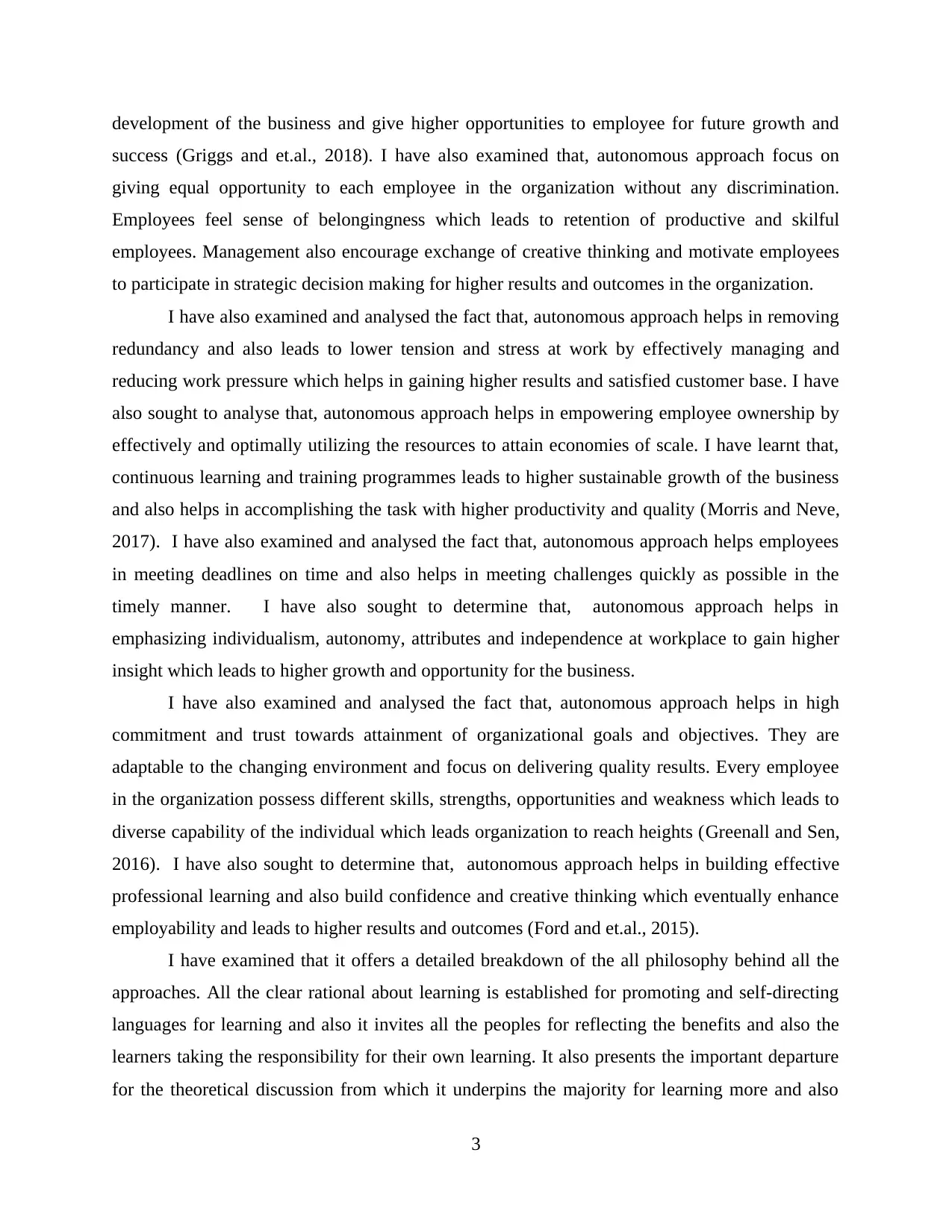
development of the business and give higher opportunities to employee for future growth and
success (Griggs and et.al., 2018). I have also examined that, autonomous approach focus on
giving equal opportunity to each employee in the organization without any discrimination.
Employees feel sense of belongingness which leads to retention of productive and skilful
employees. Management also encourage exchange of creative thinking and motivate employees
to participate in strategic decision making for higher results and outcomes in the organization.
I have also examined and analysed the fact that, autonomous approach helps in removing
redundancy and also leads to lower tension and stress at work by effectively managing and
reducing work pressure which helps in gaining higher results and satisfied customer base. I have
also sought to analyse that, autonomous approach helps in empowering employee ownership by
effectively and optimally utilizing the resources to attain economies of scale. I have learnt that,
continuous learning and training programmes leads to higher sustainable growth of the business
and also helps in accomplishing the task with higher productivity and quality (Morris and Neve,
2017). I have also examined and analysed the fact that, autonomous approach helps employees
in meeting deadlines on time and also helps in meeting challenges quickly as possible in the
timely manner. I have also sought to determine that, autonomous approach helps in
emphasizing individualism, autonomy, attributes and independence at workplace to gain higher
insight which leads to higher growth and opportunity for the business.
I have also examined and analysed the fact that, autonomous approach helps in high
commitment and trust towards attainment of organizational goals and objectives. They are
adaptable to the changing environment and focus on delivering quality results. Every employee
in the organization possess different skills, strengths, opportunities and weakness which leads to
diverse capability of the individual which leads organization to reach heights (Greenall and Sen,
2016). I have also sought to determine that, autonomous approach helps in building effective
professional learning and also build confidence and creative thinking which eventually enhance
employability and leads to higher results and outcomes (Ford and et.al., 2015).
I have examined that it offers a detailed breakdown of the all philosophy behind all the
approaches. All the clear rational about learning is established for promoting and self-directing
languages for learning and also it invites all the peoples for reflecting the benefits and also the
learners taking the responsibility for their own learning. It also presents the important departure
for the theoretical discussion from which it underpins the majority for learning more and also
3
success (Griggs and et.al., 2018). I have also examined that, autonomous approach focus on
giving equal opportunity to each employee in the organization without any discrimination.
Employees feel sense of belongingness which leads to retention of productive and skilful
employees. Management also encourage exchange of creative thinking and motivate employees
to participate in strategic decision making for higher results and outcomes in the organization.
I have also examined and analysed the fact that, autonomous approach helps in removing
redundancy and also leads to lower tension and stress at work by effectively managing and
reducing work pressure which helps in gaining higher results and satisfied customer base. I have
also sought to analyse that, autonomous approach helps in empowering employee ownership by
effectively and optimally utilizing the resources to attain economies of scale. I have learnt that,
continuous learning and training programmes leads to higher sustainable growth of the business
and also helps in accomplishing the task with higher productivity and quality (Morris and Neve,
2017). I have also examined and analysed the fact that, autonomous approach helps employees
in meeting deadlines on time and also helps in meeting challenges quickly as possible in the
timely manner. I have also sought to determine that, autonomous approach helps in
emphasizing individualism, autonomy, attributes and independence at workplace to gain higher
insight which leads to higher growth and opportunity for the business.
I have also examined and analysed the fact that, autonomous approach helps in high
commitment and trust towards attainment of organizational goals and objectives. They are
adaptable to the changing environment and focus on delivering quality results. Every employee
in the organization possess different skills, strengths, opportunities and weakness which leads to
diverse capability of the individual which leads organization to reach heights (Greenall and Sen,
2016). I have also sought to determine that, autonomous approach helps in building effective
professional learning and also build confidence and creative thinking which eventually enhance
employability and leads to higher results and outcomes (Ford and et.al., 2015).
I have examined that it offers a detailed breakdown of the all philosophy behind all the
approaches. All the clear rational about learning is established for promoting and self-directing
languages for learning and also it invites all the peoples for reflecting the benefits and also the
learners taking the responsibility for their own learning. It also presents the important departure
for the theoretical discussion from which it underpins the majority for learning more and also
3
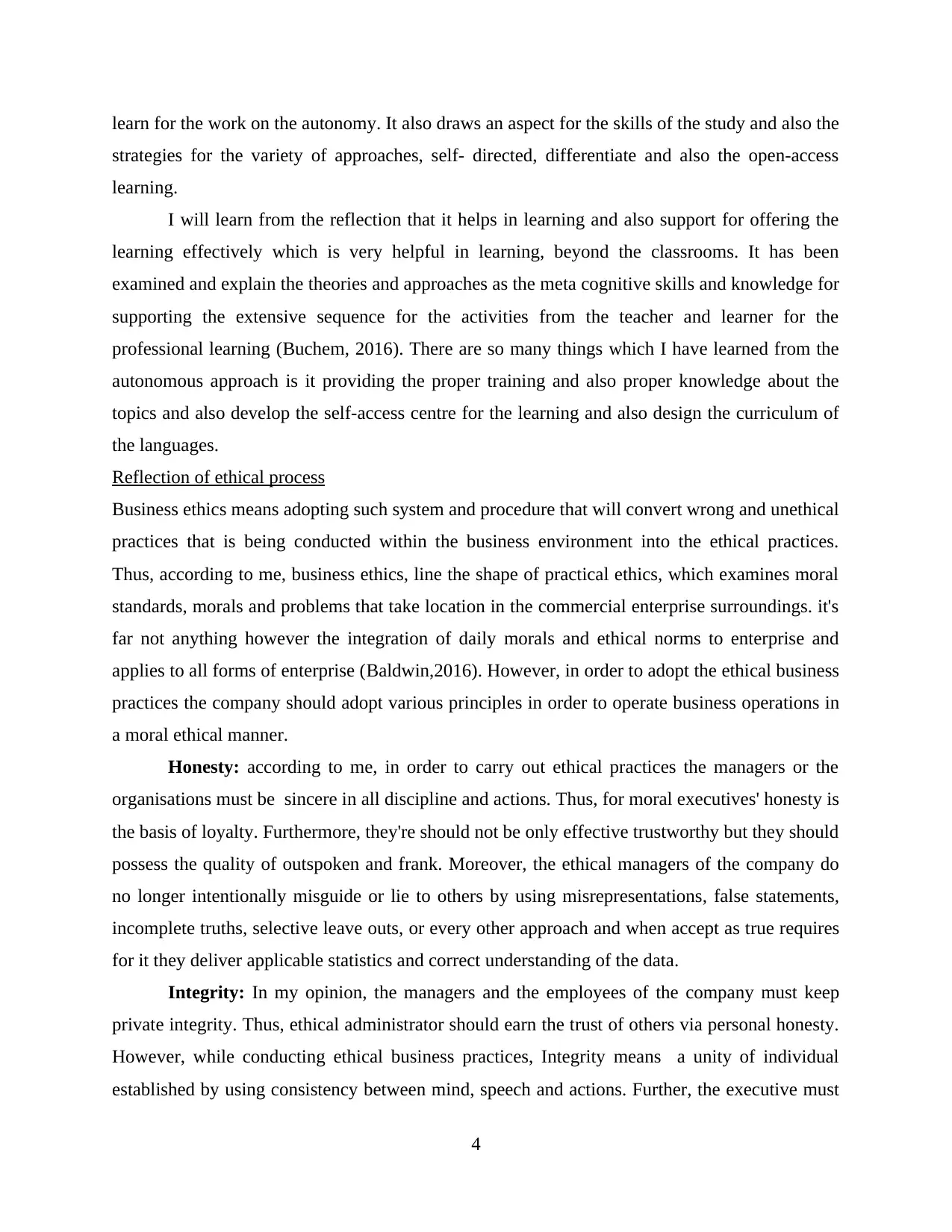
learn for the work on the autonomy. It also draws an aspect for the skills of the study and also the
strategies for the variety of approaches, self- directed, differentiate and also the open-access
learning.
I will learn from the reflection that it helps in learning and also support for offering the
learning effectively which is very helpful in learning, beyond the classrooms. It has been
examined and explain the theories and approaches as the meta cognitive skills and knowledge for
supporting the extensive sequence for the activities from the teacher and learner for the
professional learning (Buchem, 2016). There are so many things which I have learned from the
autonomous approach is it providing the proper training and also proper knowledge about the
topics and also develop the self-access centre for the learning and also design the curriculum of
the languages.
Reflection of ethical process
Business ethics means adopting such system and procedure that will convert wrong and unethical
practices that is being conducted within the business environment into the ethical practices.
Thus, according to me, business ethics, line the shape of practical ethics, which examines moral
standards, morals and problems that take location in the commercial enterprise surroundings. it's
far not anything however the integration of daily morals and ethical norms to enterprise and
applies to all forms of enterprise (Baldwin,2016). However, in order to adopt the ethical business
practices the company should adopt various principles in order to operate business operations in
a moral ethical manner.
Honesty: according to me, in order to carry out ethical practices the managers or the
organisations must be sincere in all discipline and actions. Thus, for moral executives' honesty is
the basis of loyalty. Furthermore, they're should not be only effective trustworthy but they should
possess the quality of outspoken and frank. Moreover, the ethical managers of the company do
no longer intentionally misguide or lie to others by using misrepresentations, false statements,
incomplete truths, selective leave outs, or every other approach and when accept as true requires
for it they deliver applicable statistics and correct understanding of the data.
Integrity: In my opinion, the managers and the employees of the company must keep
private integrity. Thus, ethical administrator should earn the trust of others via personal honesty.
However, while conducting ethical business practices, Integrity means a unity of individual
established by using consistency between mind, speech and actions. Further, the executive must
4
strategies for the variety of approaches, self- directed, differentiate and also the open-access
learning.
I will learn from the reflection that it helps in learning and also support for offering the
learning effectively which is very helpful in learning, beyond the classrooms. It has been
examined and explain the theories and approaches as the meta cognitive skills and knowledge for
supporting the extensive sequence for the activities from the teacher and learner for the
professional learning (Buchem, 2016). There are so many things which I have learned from the
autonomous approach is it providing the proper training and also proper knowledge about the
topics and also develop the self-access centre for the learning and also design the curriculum of
the languages.
Reflection of ethical process
Business ethics means adopting such system and procedure that will convert wrong and unethical
practices that is being conducted within the business environment into the ethical practices.
Thus, according to me, business ethics, line the shape of practical ethics, which examines moral
standards, morals and problems that take location in the commercial enterprise surroundings. it's
far not anything however the integration of daily morals and ethical norms to enterprise and
applies to all forms of enterprise (Baldwin,2016). However, in order to adopt the ethical business
practices the company should adopt various principles in order to operate business operations in
a moral ethical manner.
Honesty: according to me, in order to carry out ethical practices the managers or the
organisations must be sincere in all discipline and actions. Thus, for moral executives' honesty is
the basis of loyalty. Furthermore, they're should not be only effective trustworthy but they should
possess the quality of outspoken and frank. Moreover, the ethical managers of the company do
no longer intentionally misguide or lie to others by using misrepresentations, false statements,
incomplete truths, selective leave outs, or every other approach and when accept as true requires
for it they deliver applicable statistics and correct understanding of the data.
Integrity: In my opinion, the managers and the employees of the company must keep
private integrity. Thus, ethical administrator should earn the trust of others via personal honesty.
However, while conducting ethical business practices, Integrity means a unity of individual
established by using consistency between mind, speech and actions. Further, the executive must
4
⊘ This is a preview!⊘
Do you want full access?
Subscribe today to unlock all pages.

Trusted by 1+ million students worldwide
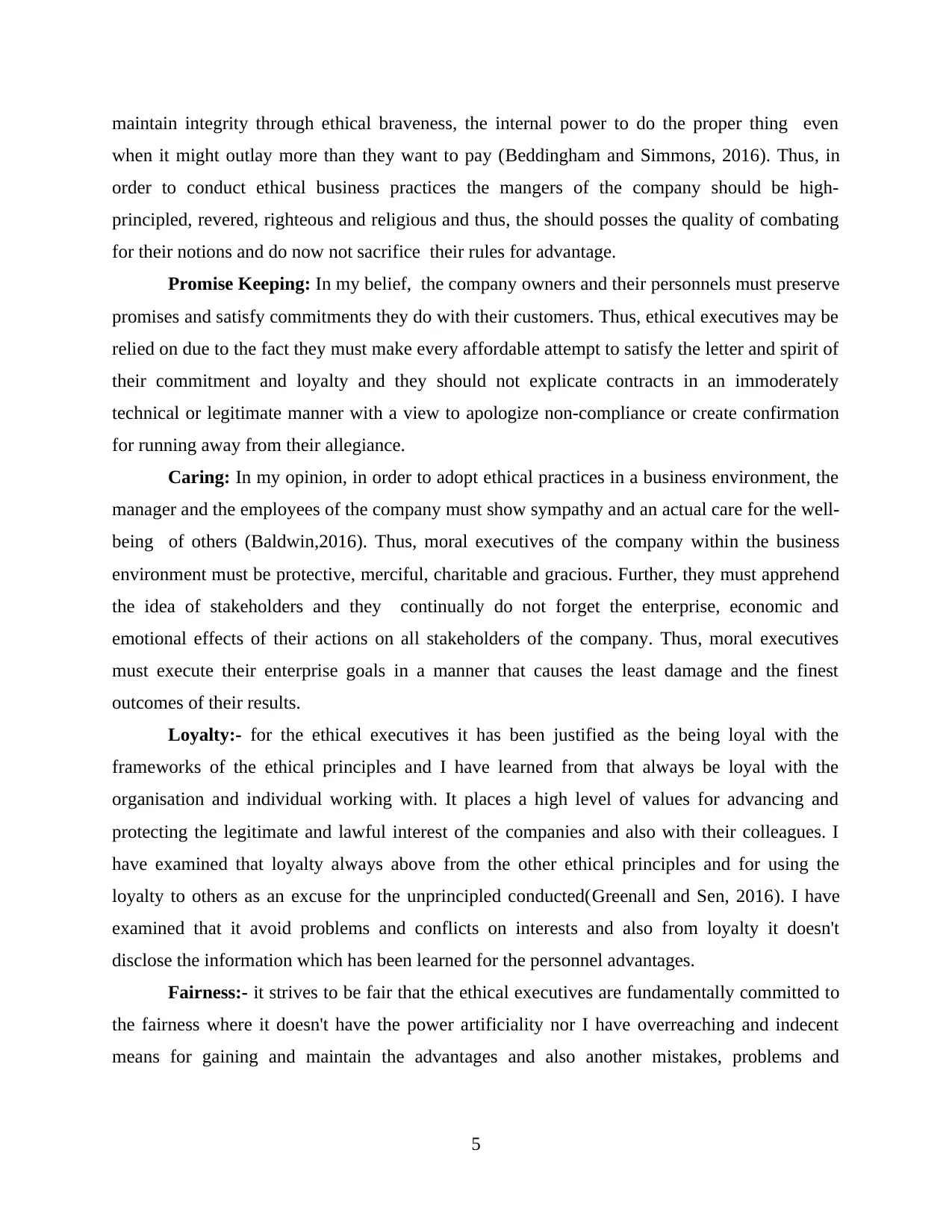
maintain integrity through ethical braveness, the internal power to do the proper thing even
when it might outlay more than they want to pay (Beddingham and Simmons, 2016). Thus, in
order to conduct ethical business practices the mangers of the company should be high-
principled, revered, righteous and religious and thus, the should posses the quality of combating
for their notions and do now not sacrifice their rules for advantage.
Promise Keeping: In my belief, the company owners and their personnels must preserve
promises and satisfy commitments they do with their customers. Thus, ethical executives may be
relied on due to the fact they must make every affordable attempt to satisfy the letter and spirit of
their commitment and loyalty and they should not explicate contracts in an immoderately
technical or legitimate manner with a view to apologize non-compliance or create confirmation
for running away from their allegiance.
Caring: In my opinion, in order to adopt ethical practices in a business environment, the
manager and the employees of the company must show sympathy and an actual care for the well-
being of others (Baldwin,2016). Thus, moral executives of the company within the business
environment must be protective, merciful, charitable and gracious. Further, they must apprehend
the idea of stakeholders and they continually do not forget the enterprise, economic and
emotional effects of their actions on all stakeholders of the company. Thus, moral executives
must execute their enterprise goals in a manner that causes the least damage and the finest
outcomes of their results.
Loyalty:- for the ethical executives it has been justified as the being loyal with the
frameworks of the ethical principles and I have learned from that always be loyal with the
organisation and individual working with. It places a high level of values for advancing and
protecting the legitimate and lawful interest of the companies and also with their colleagues. I
have examined that loyalty always above from the other ethical principles and for using the
loyalty to others as an excuse for the unprincipled conducted(Greenall and Sen, 2016). I have
examined that it avoid problems and conflicts on interests and also from loyalty it doesn't
disclose the information which has been learned for the personnel advantages.
Fairness:- it strives to be fair that the ethical executives are fundamentally committed to
the fairness where it doesn't have the power artificiality nor I have overreaching and indecent
means for gaining and maintain the advantages and also another mistakes, problems and
5
when it might outlay more than they want to pay (Beddingham and Simmons, 2016). Thus, in
order to conduct ethical business practices the mangers of the company should be high-
principled, revered, righteous and religious and thus, the should posses the quality of combating
for their notions and do now not sacrifice their rules for advantage.
Promise Keeping: In my belief, the company owners and their personnels must preserve
promises and satisfy commitments they do with their customers. Thus, ethical executives may be
relied on due to the fact they must make every affordable attempt to satisfy the letter and spirit of
their commitment and loyalty and they should not explicate contracts in an immoderately
technical or legitimate manner with a view to apologize non-compliance or create confirmation
for running away from their allegiance.
Caring: In my opinion, in order to adopt ethical practices in a business environment, the
manager and the employees of the company must show sympathy and an actual care for the well-
being of others (Baldwin,2016). Thus, moral executives of the company within the business
environment must be protective, merciful, charitable and gracious. Further, they must apprehend
the idea of stakeholders and they continually do not forget the enterprise, economic and
emotional effects of their actions on all stakeholders of the company. Thus, moral executives
must execute their enterprise goals in a manner that causes the least damage and the finest
outcomes of their results.
Loyalty:- for the ethical executives it has been justified as the being loyal with the
frameworks of the ethical principles and I have learned from that always be loyal with the
organisation and individual working with. It places a high level of values for advancing and
protecting the legitimate and lawful interest of the companies and also with their colleagues. I
have examined that loyalty always above from the other ethical principles and for using the
loyalty to others as an excuse for the unprincipled conducted(Greenall and Sen, 2016). I have
examined that it avoid problems and conflicts on interests and also from loyalty it doesn't
disclose the information which has been learned for the personnel advantages.
Fairness:- it strives to be fair that the ethical executives are fundamentally committed to
the fairness where it doesn't have the power artificiality nor I have overreaching and indecent
means for gaining and maintain the advantages and also another mistakes, problems and
5
Paraphrase This Document
Need a fresh take? Get an instant paraphrase of this document with our AI Paraphraser
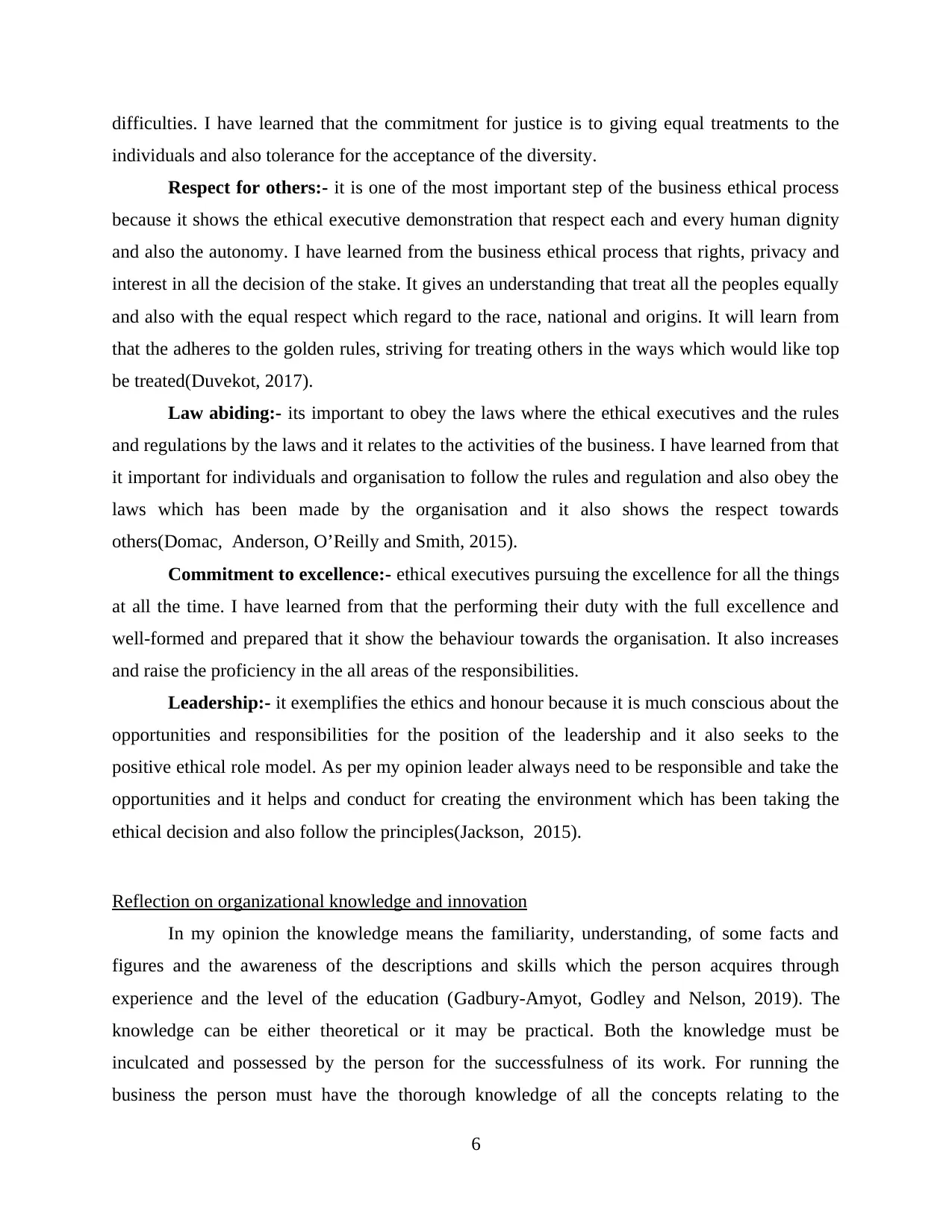
difficulties. I have learned that the commitment for justice is to giving equal treatments to the
individuals and also tolerance for the acceptance of the diversity.
Respect for others:- it is one of the most important step of the business ethical process
because it shows the ethical executive demonstration that respect each and every human dignity
and also the autonomy. I have learned from the business ethical process that rights, privacy and
interest in all the decision of the stake. It gives an understanding that treat all the peoples equally
and also with the equal respect which regard to the race, national and origins. It will learn from
that the adheres to the golden rules, striving for treating others in the ways which would like top
be treated(Duvekot, 2017).
Law abiding:- its important to obey the laws where the ethical executives and the rules
and regulations by the laws and it relates to the activities of the business. I have learned from that
it important for individuals and organisation to follow the rules and regulation and also obey the
laws which has been made by the organisation and it also shows the respect towards
others(Domac, Anderson, O’Reilly and Smith, 2015).
Commitment to excellence:- ethical executives pursuing the excellence for all the things
at all the time. I have learned from that the performing their duty with the full excellence and
well-formed and prepared that it show the behaviour towards the organisation. It also increases
and raise the proficiency in the all areas of the responsibilities.
Leadership:- it exemplifies the ethics and honour because it is much conscious about the
opportunities and responsibilities for the position of the leadership and it also seeks to the
positive ethical role model. As per my opinion leader always need to be responsible and take the
opportunities and it helps and conduct for creating the environment which has been taking the
ethical decision and also follow the principles(Jackson, 2015).
Reflection on organizational knowledge and innovation
In my opinion the knowledge means the familiarity, understanding, of some facts and
figures and the awareness of the descriptions and skills which the person acquires through
experience and the level of the education (Gadbury-Amyot, Godley and Nelson, 2019). The
knowledge can be either theoretical or it may be practical. Both the knowledge must be
inculcated and possessed by the person for the successfulness of its work. For running the
business the person must have the thorough knowledge of all the concepts relating to the
6
individuals and also tolerance for the acceptance of the diversity.
Respect for others:- it is one of the most important step of the business ethical process
because it shows the ethical executive demonstration that respect each and every human dignity
and also the autonomy. I have learned from the business ethical process that rights, privacy and
interest in all the decision of the stake. It gives an understanding that treat all the peoples equally
and also with the equal respect which regard to the race, national and origins. It will learn from
that the adheres to the golden rules, striving for treating others in the ways which would like top
be treated(Duvekot, 2017).
Law abiding:- its important to obey the laws where the ethical executives and the rules
and regulations by the laws and it relates to the activities of the business. I have learned from that
it important for individuals and organisation to follow the rules and regulation and also obey the
laws which has been made by the organisation and it also shows the respect towards
others(Domac, Anderson, O’Reilly and Smith, 2015).
Commitment to excellence:- ethical executives pursuing the excellence for all the things
at all the time. I have learned from that the performing their duty with the full excellence and
well-formed and prepared that it show the behaviour towards the organisation. It also increases
and raise the proficiency in the all areas of the responsibilities.
Leadership:- it exemplifies the ethics and honour because it is much conscious about the
opportunities and responsibilities for the position of the leadership and it also seeks to the
positive ethical role model. As per my opinion leader always need to be responsible and take the
opportunities and it helps and conduct for creating the environment which has been taking the
ethical decision and also follow the principles(Jackson, 2015).
Reflection on organizational knowledge and innovation
In my opinion the knowledge means the familiarity, understanding, of some facts and
figures and the awareness of the descriptions and skills which the person acquires through
experience and the level of the education (Gadbury-Amyot, Godley and Nelson, 2019). The
knowledge can be either theoretical or it may be practical. Both the knowledge must be
inculcated and possessed by the person for the successfulness of its work. For running the
business the person must have the thorough knowledge of all the concepts relating to the
6
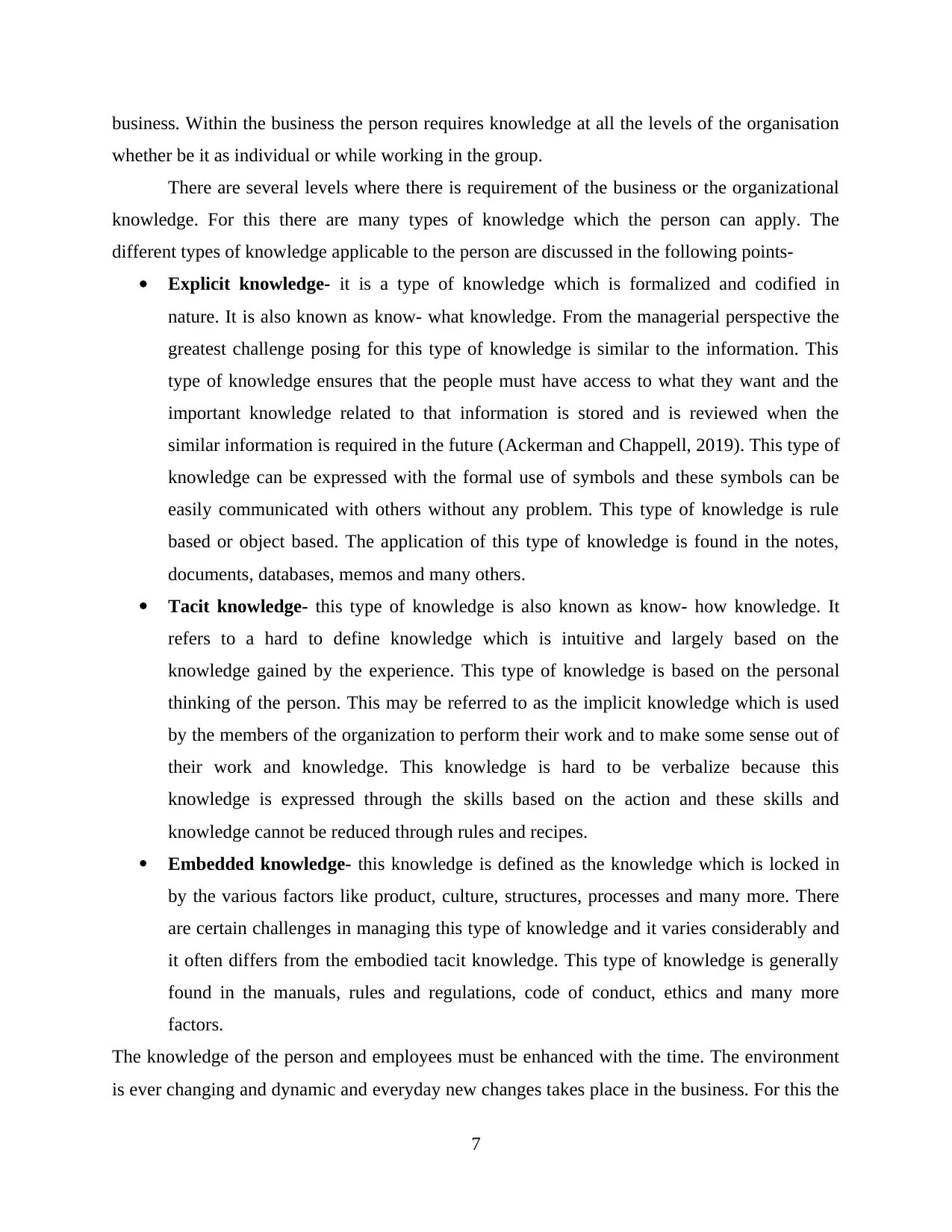
business. Within the business the person requires knowledge at all the levels of the organisation
whether be it as individual or while working in the group.
There are several levels where there is requirement of the business or the organizational
knowledge. For this there are many types of knowledge which the person can apply. The
different types of knowledge applicable to the person are discussed in the following points-
Explicit knowledge- it is a type of knowledge which is formalized and codified in
nature. It is also known as know- what knowledge. From the managerial perspective the
greatest challenge posing for this type of knowledge is similar to the information. This
type of knowledge ensures that the people must have access to what they want and the
important knowledge related to that information is stored and is reviewed when the
similar information is required in the future (Ackerman and Chappell, 2019). This type of
knowledge can be expressed with the formal use of symbols and these symbols can be
easily communicated with others without any problem. This type of knowledge is rule
based or object based. The application of this type of knowledge is found in the notes,
documents, databases, memos and many others.
Tacit knowledge- this type of knowledge is also known as know- how knowledge. It
refers to a hard to define knowledge which is intuitive and largely based on the
knowledge gained by the experience. This type of knowledge is based on the personal
thinking of the person. This may be referred to as the implicit knowledge which is used
by the members of the organization to perform their work and to make some sense out of
their work and knowledge. This knowledge is hard to be verbalize because this
knowledge is expressed through the skills based on the action and these skills and
knowledge cannot be reduced through rules and recipes.
Embedded knowledge- this knowledge is defined as the knowledge which is locked in
by the various factors like product, culture, structures, processes and many more. There
are certain challenges in managing this type of knowledge and it varies considerably and
it often differs from the embodied tacit knowledge. This type of knowledge is generally
found in the manuals, rules and regulations, code of conduct, ethics and many more
factors.
The knowledge of the person and employees must be enhanced with the time. The environment
is ever changing and dynamic and everyday new changes takes place in the business. For this the
7
whether be it as individual or while working in the group.
There are several levels where there is requirement of the business or the organizational
knowledge. For this there are many types of knowledge which the person can apply. The
different types of knowledge applicable to the person are discussed in the following points-
Explicit knowledge- it is a type of knowledge which is formalized and codified in
nature. It is also known as know- what knowledge. From the managerial perspective the
greatest challenge posing for this type of knowledge is similar to the information. This
type of knowledge ensures that the people must have access to what they want and the
important knowledge related to that information is stored and is reviewed when the
similar information is required in the future (Ackerman and Chappell, 2019). This type of
knowledge can be expressed with the formal use of symbols and these symbols can be
easily communicated with others without any problem. This type of knowledge is rule
based or object based. The application of this type of knowledge is found in the notes,
documents, databases, memos and many others.
Tacit knowledge- this type of knowledge is also known as know- how knowledge. It
refers to a hard to define knowledge which is intuitive and largely based on the
knowledge gained by the experience. This type of knowledge is based on the personal
thinking of the person. This may be referred to as the implicit knowledge which is used
by the members of the organization to perform their work and to make some sense out of
their work and knowledge. This knowledge is hard to be verbalize because this
knowledge is expressed through the skills based on the action and these skills and
knowledge cannot be reduced through rules and recipes.
Embedded knowledge- this knowledge is defined as the knowledge which is locked in
by the various factors like product, culture, structures, processes and many more. There
are certain challenges in managing this type of knowledge and it varies considerably and
it often differs from the embodied tacit knowledge. This type of knowledge is generally
found in the manuals, rules and regulations, code of conduct, ethics and many more
factors.
The knowledge of the person and employees must be enhanced with the time. The environment
is ever changing and dynamic and everyday new changes takes place in the business. For this the
7
⊘ This is a preview!⊘
Do you want full access?
Subscribe today to unlock all pages.

Trusted by 1+ million students worldwide
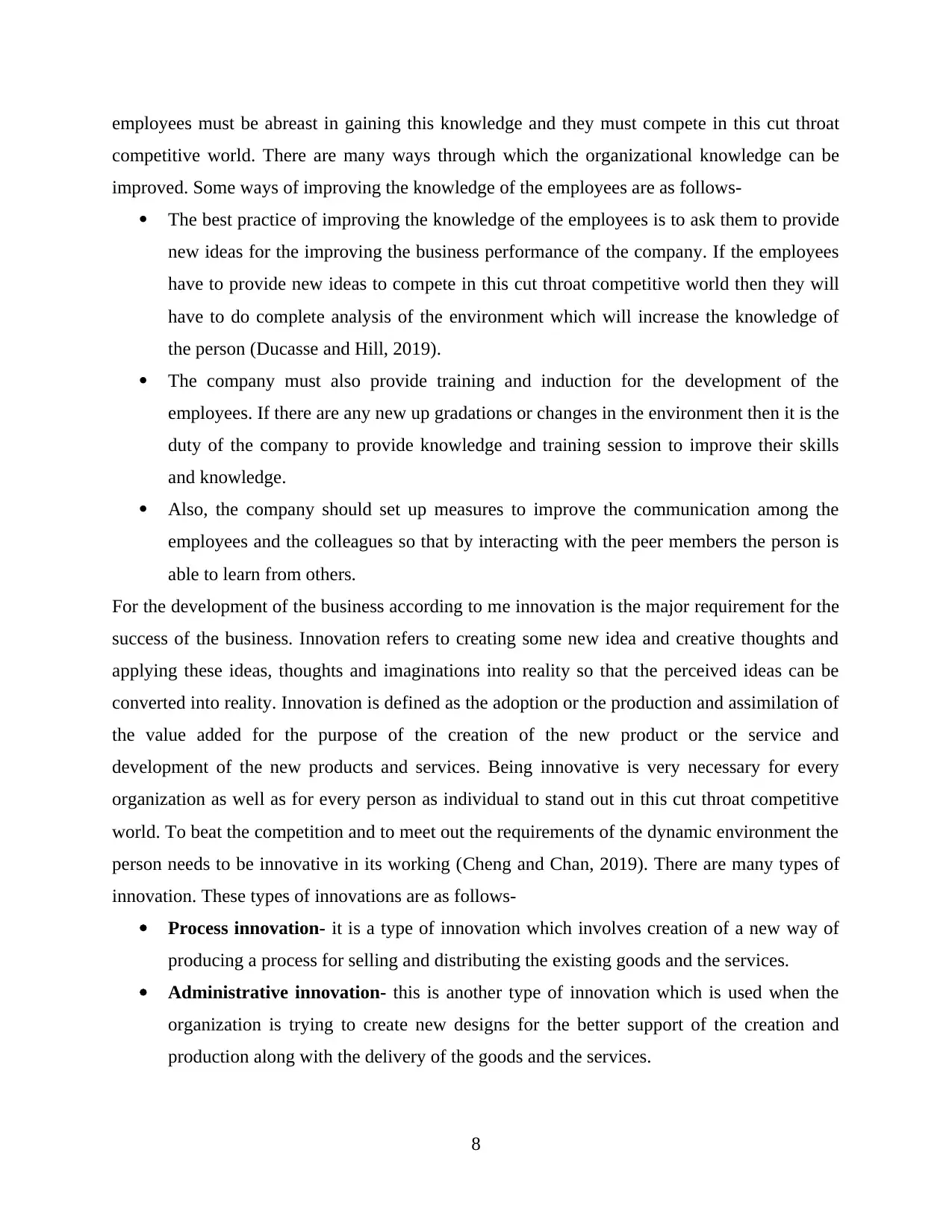
employees must be abreast in gaining this knowledge and they must compete in this cut throat
competitive world. There are many ways through which the organizational knowledge can be
improved. Some ways of improving the knowledge of the employees are as follows-
The best practice of improving the knowledge of the employees is to ask them to provide
new ideas for the improving the business performance of the company. If the employees
have to provide new ideas to compete in this cut throat competitive world then they will
have to do complete analysis of the environment which will increase the knowledge of
the person (Ducasse and Hill, 2019).
The company must also provide training and induction for the development of the
employees. If there are any new up gradations or changes in the environment then it is the
duty of the company to provide knowledge and training session to improve their skills
and knowledge.
Also, the company should set up measures to improve the communication among the
employees and the colleagues so that by interacting with the peer members the person is
able to learn from others.
For the development of the business according to me innovation is the major requirement for the
success of the business. Innovation refers to creating some new idea and creative thoughts and
applying these ideas, thoughts and imaginations into reality so that the perceived ideas can be
converted into reality. Innovation is defined as the adoption or the production and assimilation of
the value added for the purpose of the creation of the new product or the service and
development of the new products and services. Being innovative is very necessary for every
organization as well as for every person as individual to stand out in this cut throat competitive
world. To beat the competition and to meet out the requirements of the dynamic environment the
person needs to be innovative in its working (Cheng and Chan, 2019). There are many types of
innovation. These types of innovations are as follows-
Process innovation- it is a type of innovation which involves creation of a new way of
producing a process for selling and distributing the existing goods and the services.
Administrative innovation- this is another type of innovation which is used when the
organization is trying to create new designs for the better support of the creation and
production along with the delivery of the goods and the services.
8
competitive world. There are many ways through which the organizational knowledge can be
improved. Some ways of improving the knowledge of the employees are as follows-
The best practice of improving the knowledge of the employees is to ask them to provide
new ideas for the improving the business performance of the company. If the employees
have to provide new ideas to compete in this cut throat competitive world then they will
have to do complete analysis of the environment which will increase the knowledge of
the person (Ducasse and Hill, 2019).
The company must also provide training and induction for the development of the
employees. If there are any new up gradations or changes in the environment then it is the
duty of the company to provide knowledge and training session to improve their skills
and knowledge.
Also, the company should set up measures to improve the communication among the
employees and the colleagues so that by interacting with the peer members the person is
able to learn from others.
For the development of the business according to me innovation is the major requirement for the
success of the business. Innovation refers to creating some new idea and creative thoughts and
applying these ideas, thoughts and imaginations into reality so that the perceived ideas can be
converted into reality. Innovation is defined as the adoption or the production and assimilation of
the value added for the purpose of the creation of the new product or the service and
development of the new products and services. Being innovative is very necessary for every
organization as well as for every person as individual to stand out in this cut throat competitive
world. To beat the competition and to meet out the requirements of the dynamic environment the
person needs to be innovative in its working (Cheng and Chan, 2019). There are many types of
innovation. These types of innovations are as follows-
Process innovation- it is a type of innovation which involves creation of a new way of
producing a process for selling and distributing the existing goods and the services.
Administrative innovation- this is another type of innovation which is used when the
organization is trying to create new designs for the better support of the creation and
production along with the delivery of the goods and the services.
8
Paraphrase This Document
Need a fresh take? Get an instant paraphrase of this document with our AI Paraphraser
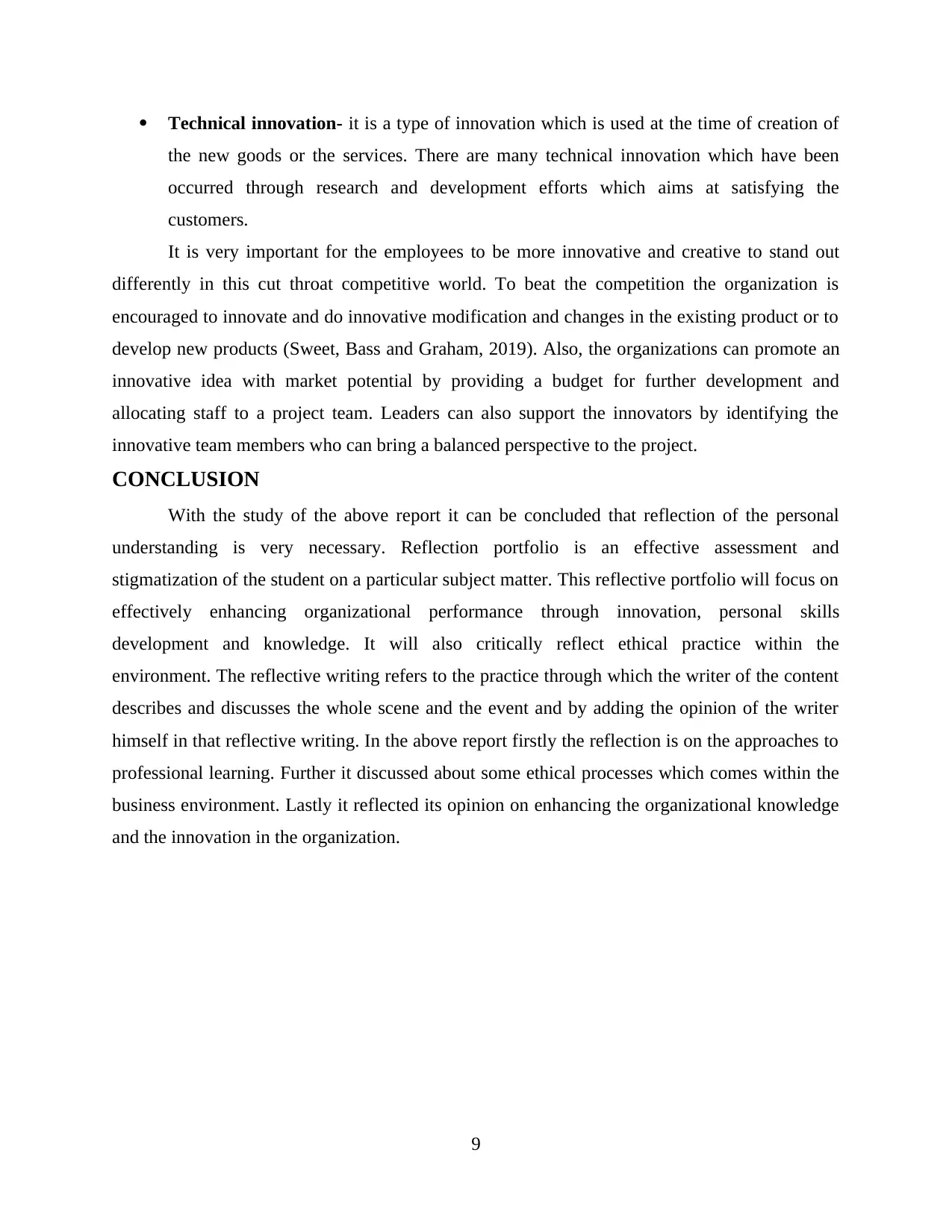
Technical innovation- it is a type of innovation which is used at the time of creation of
the new goods or the services. There are many technical innovation which have been
occurred through research and development efforts which aims at satisfying the
customers.
It is very important for the employees to be more innovative and creative to stand out
differently in this cut throat competitive world. To beat the competition the organization is
encouraged to innovate and do innovative modification and changes in the existing product or to
develop new products (Sweet, Bass and Graham, 2019). Also, the organizations can promote an
innovative idea with market potential by providing a budget for further development and
allocating staff to a project team. Leaders can also support the innovators by identifying the
innovative team members who can bring a balanced perspective to the project.
CONCLUSION
With the study of the above report it can be concluded that reflection of the personal
understanding is very necessary. Reflection portfolio is an effective assessment and
stigmatization of the student on a particular subject matter. This reflective portfolio will focus on
effectively enhancing organizational performance through innovation, personal skills
development and knowledge. It will also critically reflect ethical practice within the
environment. The reflective writing refers to the practice through which the writer of the content
describes and discusses the whole scene and the event and by adding the opinion of the writer
himself in that reflective writing. In the above report firstly the reflection is on the approaches to
professional learning. Further it discussed about some ethical processes which comes within the
business environment. Lastly it reflected its opinion on enhancing the organizational knowledge
and the innovation in the organization.
9
the new goods or the services. There are many technical innovation which have been
occurred through research and development efforts which aims at satisfying the
customers.
It is very important for the employees to be more innovative and creative to stand out
differently in this cut throat competitive world. To beat the competition the organization is
encouraged to innovate and do innovative modification and changes in the existing product or to
develop new products (Sweet, Bass and Graham, 2019). Also, the organizations can promote an
innovative idea with market potential by providing a budget for further development and
allocating staff to a project team. Leaders can also support the innovators by identifying the
innovative team members who can bring a balanced perspective to the project.
CONCLUSION
With the study of the above report it can be concluded that reflection of the personal
understanding is very necessary. Reflection portfolio is an effective assessment and
stigmatization of the student on a particular subject matter. This reflective portfolio will focus on
effectively enhancing organizational performance through innovation, personal skills
development and knowledge. It will also critically reflect ethical practice within the
environment. The reflective writing refers to the practice through which the writer of the content
describes and discusses the whole scene and the event and by adding the opinion of the writer
himself in that reflective writing. In the above report firstly the reflection is on the approaches to
professional learning. Further it discussed about some ethical processes which comes within the
business environment. Lastly it reflected its opinion on enhancing the organizational knowledge
and the innovation in the organization.
9
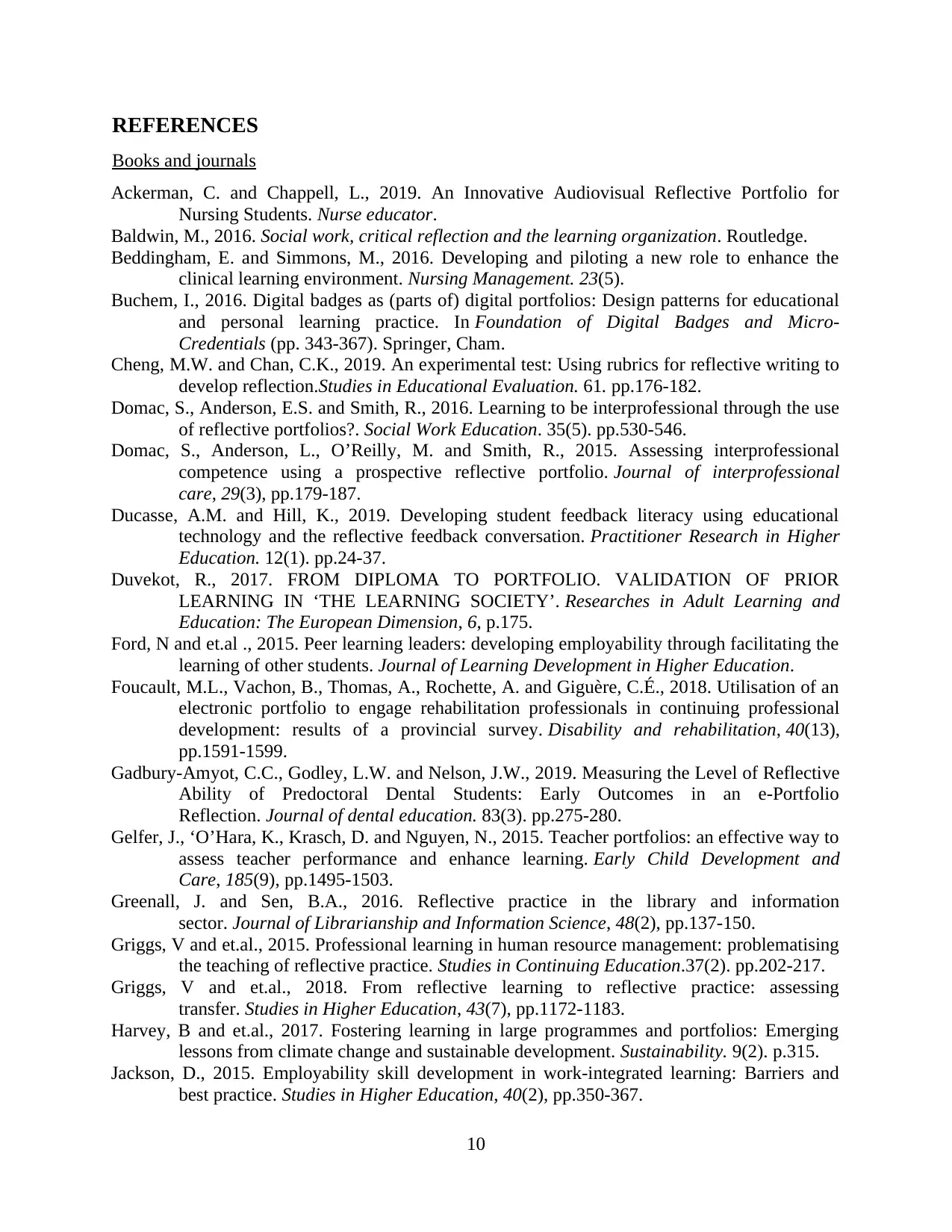
REFERENCES
Books and journals
Ackerman, C. and Chappell, L., 2019. An Innovative Audiovisual Reflective Portfolio for
Nursing Students. Nurse educator.
Baldwin, M., 2016. Social work, critical reflection and the learning organization. Routledge.
Beddingham, E. and Simmons, M., 2016. Developing and piloting a new role to enhance the
clinical learning environment. Nursing Management. 23(5).
Buchem, I., 2016. Digital badges as (parts of) digital portfolios: Design patterns for educational
and personal learning practice. In Foundation of Digital Badges and Micro-
Credentials (pp. 343-367). Springer, Cham.
Cheng, M.W. and Chan, C.K., 2019. An experimental test: Using rubrics for reflective writing to
develop reflection.Studies in Educational Evaluation. 61. pp.176-182.
Domac, S., Anderson, E.S. and Smith, R., 2016. Learning to be interprofessional through the use
of reflective portfolios?. Social Work Education. 35(5). pp.530-546.
Domac, S., Anderson, L., O’Reilly, M. and Smith, R., 2015. Assessing interprofessional
competence using a prospective reflective portfolio. Journal of interprofessional
care, 29(3), pp.179-187.
Ducasse, A.M. and Hill, K., 2019. Developing student feedback literacy using educational
technology and the reflective feedback conversation. Practitioner Research in Higher
Education. 12(1). pp.24-37.
Duvekot, R., 2017. FROM DIPLOMA TO PORTFOLIO. VALIDATION OF PRIOR
LEARNING IN ‘THE LEARNING SOCIETY’. Researches in Adult Learning and
Education: The European Dimension, 6, p.175.
Ford, N and et.al ., 2015. Peer learning leaders: developing employability through facilitating the
learning of other students. Journal of Learning Development in Higher Education.
Foucault, M.L., Vachon, B., Thomas, A., Rochette, A. and Giguère, C.É., 2018. Utilisation of an
electronic portfolio to engage rehabilitation professionals in continuing professional
development: results of a provincial survey. Disability and rehabilitation, 40(13),
pp.1591-1599.
Gadbury-Amyot, C.C., Godley, L.W. and Nelson, J.W., 2019. Measuring the Level of Reflective
Ability of Predoctoral Dental Students: Early Outcomes in an e-Portfolio
Reflection. Journal of dental education. 83(3). pp.275-280.
Gelfer, J., ‘O’Hara, K., Krasch, D. and Nguyen, N., 2015. Teacher portfolios: an effective way to
assess teacher performance and enhance learning. Early Child Development and
Care, 185(9), pp.1495-1503.
Greenall, J. and Sen, B.A., 2016. Reflective practice in the library and information
sector. Journal of Librarianship and Information Science, 48(2), pp.137-150.
Griggs, V and et.al., 2015. Professional learning in human resource management: problematising
the teaching of reflective practice. Studies in Continuing Education.37(2). pp.202-217.
Griggs, V and et.al., 2018. From reflective learning to reflective practice: assessing
transfer. Studies in Higher Education, 43(7), pp.1172-1183.
Harvey, B and et.al., 2017. Fostering learning in large programmes and portfolios: Emerging
lessons from climate change and sustainable development. Sustainability. 9(2). p.315.
Jackson, D., 2015. Employability skill development in work-integrated learning: Barriers and
best practice. Studies in Higher Education, 40(2), pp.350-367.
10
Books and journals
Ackerman, C. and Chappell, L., 2019. An Innovative Audiovisual Reflective Portfolio for
Nursing Students. Nurse educator.
Baldwin, M., 2016. Social work, critical reflection and the learning organization. Routledge.
Beddingham, E. and Simmons, M., 2016. Developing and piloting a new role to enhance the
clinical learning environment. Nursing Management. 23(5).
Buchem, I., 2016. Digital badges as (parts of) digital portfolios: Design patterns for educational
and personal learning practice. In Foundation of Digital Badges and Micro-
Credentials (pp. 343-367). Springer, Cham.
Cheng, M.W. and Chan, C.K., 2019. An experimental test: Using rubrics for reflective writing to
develop reflection.Studies in Educational Evaluation. 61. pp.176-182.
Domac, S., Anderson, E.S. and Smith, R., 2016. Learning to be interprofessional through the use
of reflective portfolios?. Social Work Education. 35(5). pp.530-546.
Domac, S., Anderson, L., O’Reilly, M. and Smith, R., 2015. Assessing interprofessional
competence using a prospective reflective portfolio. Journal of interprofessional
care, 29(3), pp.179-187.
Ducasse, A.M. and Hill, K., 2019. Developing student feedback literacy using educational
technology and the reflective feedback conversation. Practitioner Research in Higher
Education. 12(1). pp.24-37.
Duvekot, R., 2017. FROM DIPLOMA TO PORTFOLIO. VALIDATION OF PRIOR
LEARNING IN ‘THE LEARNING SOCIETY’. Researches in Adult Learning and
Education: The European Dimension, 6, p.175.
Ford, N and et.al ., 2015. Peer learning leaders: developing employability through facilitating the
learning of other students. Journal of Learning Development in Higher Education.
Foucault, M.L., Vachon, B., Thomas, A., Rochette, A. and Giguère, C.É., 2018. Utilisation of an
electronic portfolio to engage rehabilitation professionals in continuing professional
development: results of a provincial survey. Disability and rehabilitation, 40(13),
pp.1591-1599.
Gadbury-Amyot, C.C., Godley, L.W. and Nelson, J.W., 2019. Measuring the Level of Reflective
Ability of Predoctoral Dental Students: Early Outcomes in an e-Portfolio
Reflection. Journal of dental education. 83(3). pp.275-280.
Gelfer, J., ‘O’Hara, K., Krasch, D. and Nguyen, N., 2015. Teacher portfolios: an effective way to
assess teacher performance and enhance learning. Early Child Development and
Care, 185(9), pp.1495-1503.
Greenall, J. and Sen, B.A., 2016. Reflective practice in the library and information
sector. Journal of Librarianship and Information Science, 48(2), pp.137-150.
Griggs, V and et.al., 2015. Professional learning in human resource management: problematising
the teaching of reflective practice. Studies in Continuing Education.37(2). pp.202-217.
Griggs, V and et.al., 2018. From reflective learning to reflective practice: assessing
transfer. Studies in Higher Education, 43(7), pp.1172-1183.
Harvey, B and et.al., 2017. Fostering learning in large programmes and portfolios: Emerging
lessons from climate change and sustainable development. Sustainability. 9(2). p.315.
Jackson, D., 2015. Employability skill development in work-integrated learning: Barriers and
best practice. Studies in Higher Education, 40(2), pp.350-367.
10
⊘ This is a preview!⊘
Do you want full access?
Subscribe today to unlock all pages.

Trusted by 1+ million students worldwide
1 out of 13
Related Documents
Your All-in-One AI-Powered Toolkit for Academic Success.
+13062052269
info@desklib.com
Available 24*7 on WhatsApp / Email
![[object Object]](/_next/static/media/star-bottom.7253800d.svg)
Unlock your academic potential
Copyright © 2020–2025 A2Z Services. All Rights Reserved. Developed and managed by ZUCOL.





